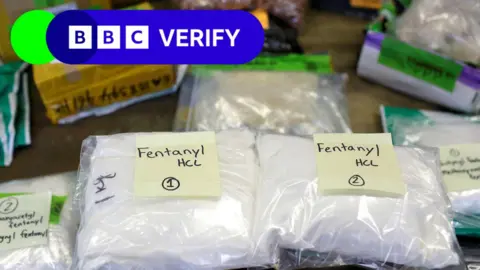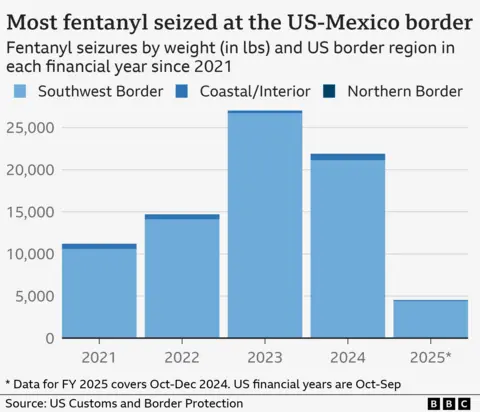How does fentanyl get into the US?
 Reuters
ReutersPresident Donald Trump has imposed his long-threatened 25% tariff on Mexican and Canadian goods, as well as a new 10% levy against China, citing the countries' failure to stop the export of chemicals used in the production of the powerful opioid fentanyl.
The US has long accused Chinese corporations of knowingly supplying groups involved in the creation of the drug. Beijing has hit back with tariffs of its own.
The White House has also accused Canada and Mexico of failing to prevent criminal gangs from smuggling fentanyl into the US.
Beijing has hit back with a 15% tariff of its own, and Canada has announced 25% tariffs against $30bn worth of US goods, with an additional $125bn worth of products to be hit over the next 21 days.
Mexico is expected to respond later on Tuesday.
How serious is the fentanyl crisis in the US?
Fentanyl is a synthetic drug manufactured from a combination of chemicals. US regulators approved it for use in medical settings as a pain reliever in the 1960s, but it has since become the main drug responsible for opioid overdose deaths in the US.
Over 74,000 Americans died in 2023 after taking drug mixtures containing fentanyl, according to the US Centers for Disease Control (CDC).
It is frequently mixed with other illicit drugs, leading many users to be unaware that the substances they are consuming contain fentanyl.
As little as a two milligram dose of fentanyl - roughly the size of a pencil tip - can be fatal.
Over the past decade, the global fentanyl supply chain has expanded, making it harder for law enforcement and policymakers to control.
China is the primary source of the precursor chemicals used to produce fentanyl.
Most fentanyl enters the US via Mexico
Since September, 7,793 lb (3,534kg) of fentanyl have been seized in the US, according to figures published by US Customs and Border Patrol (CBP).
Almost all (98%) was intercepted at the southwest border with Mexico. Less than 1% was seized across the northern US border with Canada. The remainder was from sea routes or other US checkpoints.

According to the US Drug Enforcement Agency (DEA), Mexican criminal organisations - including the Sinaloa Cartel - play a key role in producing and delivering fentanyl, methamphetamine and other illicit drugs into the US.
The chemicals used to make fentanyl are sourced from China by traffickers and turned into the finished product in labs in Mexico before being smuggled into the US.
According to the DEA, the Sinaloa Cartel uses a variety of tactics to conceal shipments coming into Mexico, such as hiding the chemicals among legitimate commercial goods, mislabelling the containers, using front companies, and shipping through third party countries.
The Trump administration has accused the Mexican government of colluding with the drug cartels. Mexico's President Sheinbaum says the claims are "slander."
In December, shortly after Trump had threatened Mexico with tariffs, the country's security forces announced their largest ever seizure of fentanyl - equivalent to around 20 million doses.
In response to the threat of tariffs from the US, on February 5th the Mexican government launched Operation Northern Border, deploying 10,000 national guard troops along the US-Mexico border.
In the latest government announcement on the operation, the Mexican government said that in the month since the operation launched, 55.9kg of fentanyl have been seized.
China is the main source of fentanyl chemicals
In 2019, China classified fentanyl as a controlled narcotic and later added some of the chemicals used to make it to the list.
Despite this, the trade in other chemicals involved in the manufacturing of fentanyl - some of which can have legitimate purposes - remain uncontrolled, as those involved in the trade find new ways to evade the law.
A review of several US indictments, which include details of undercover agents communicating with Chinese manufacturers, suggests that some chemical companies in China have been selling chemicals - including controlled ones - in the knowledge that they are intended to make fentanyl.
- US, Mexico, Canada - who got what from tariff stand-off?
- Trump sows uncertainty - and Xi Jinping sees an opportunity
- Trump's tariffs hit China hard before - this time, it's ready
Dozens of indictments reviewed by BBC Verify detail instances where Chinese manufacturers have provided instructions on how to make fentanyl from products they sell, through encrypted platforms and cryptocurrency payments.
"So you have these massive loopholes where criminals engage in selling legal products, but they knowingly sell them to criminal entities," says Vanda Felbab-Brown, senior fellow in foreign policy at the Brookings Institute.
In a statement, China said it had some of the strictest drugs laws in the world and had conducted joint operations with the US in the past.
"The US needs to view and solve its own fentanyl issue," it said.
And while China remains the main source of the chemicals used to make fentanyl, the DEA has also identified India as an emerging major source for these chemicals.
In a US indictment from January 2025, two chemical companies in India were charged with supplying the chemicals used to make fentanyl to the US and Mexico.
Canada's role in the fentanyl trade
President Trump has accused Canada - alongside Mexico - of allowing "vast numbers of people to come in and fentanyl to come in" to the US.
According to data from the US Customs and Border Patrol, only about 0.2% of all seizures of fentanyl entering the US are made at the Canadian border, almost all the rest is confiscated at the US border with Mexico.
But in January, Canada's financial intelligence agency reported that organised criminal groups in Canada are increasingly involved in the production of fentanyl by importing chemicals used to make it and lab equipment from China.
The trade in fentanyl takes place in both directions.
In the first 10 months of 2024, the Canadian border service reported seizing 10.8lb (4.9kg) of fentanyl entering from the US, while US Border Patrol intercepted 32.1lb (14.6kg) of fentanyl coming from Canada.
In December, the country pledged C$1.3bn ($900m; £700m) for combating fentanyl and enhancing border security.
And on February 11th, Prime Minister Justin Trudeau announced the appointment Kevin Brosseau, as Canada's fentanyl czar.
Additional reporting by Lucy Gilder.

